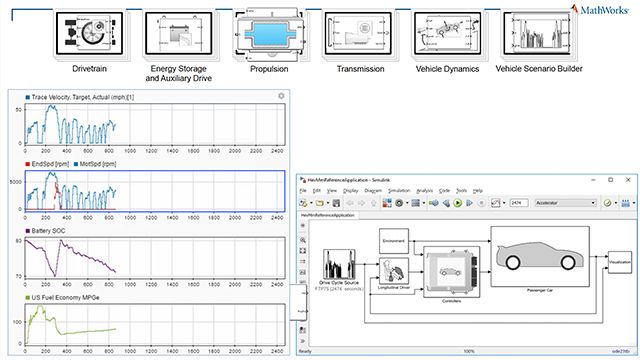MathWorks
Featured Proceedings
Converting Spreadsheet-Based Scenario Definitions to OpenSCENARIO Files
Emily Foster,
Ford Motor Company
Automotive DevOps for Model-Based Design with AWS, NXP, and MathWorks
Curt Hillier,
NXP Semiconductor
Turning the Tables on Validation with Agile Model-Based Design
Jim Ross,
MathWorks
Converting Spreadsheet-Based Scenario Definitions to OpenSCENARIO Files
The goal of this project was to create a tool to convert spreadsheet-based scenario definitions into the OpenSCENARIO standard format for easy exchange, usability, and storage for Ford engineers. Through standardization, the tool allowed for scenario reuse regardless of the simulation tool and test case format. The tool was first used to support automated conversion of scenarios defined in complicated spreadsheets to the beta version of OpenSCENARIO. This tool is capable of showing the resulting scenario in the Automated Driving Toolbox™ drivingScenario tool and exporting OpenSCENARIO 0.9.1 files representing the corresponding CarSim scenarios. Lastly, the app was modified so that users could enter information required by OpenSCENARIO to build up scenarios from other documentation—enabling reusability and easy shareability across Ford.
Emily Foster is a research engineer at Ford Motor Company. She works within the Driver Assistance Technology Modeling and Simulation Group. For the last three years, she has been involved in feature modeling and tool creation. Emily holds bachelor’s and master’s degrees in mechanical engineering from Lawrence Technological University and is a second-year Ph.D. student at Oakland University.
Automotive DevOps for Model-Based Design with AWS, NXP, and MathWorks
Vehicle features and capabilities are transitioning from being mostly mechanically defined to being software defined. OEMs are adopting agile software development methods to update and maintain this software, driving the need for DevOps. NXP Semiconductors, MathWorks, and AWS have collaborated on a DevOps solution for Model-Based Design utilizing advanced vehicle control algorithms. In this talk, NXP will present the full cloud-to-vehicle solution built with AMS CodeSuite services by using MathWorks design tools targeting NXP automotive processors. This presentation also covers NXP® Model-Based Design Toolbox supporting code execution and profiling on the NXP S32S GreenBox II and NXP S32G GoldBox.
Curt Hillier has been with NXP Semiconductors for 11 years. In this span, his work has included radar, hybrid and electric vehicle propulsion, battery management, and vehicle connectivity domains. His background is in applications engineering, covering both customer support and delivering advanced solutions and demonstrations for tradeshows, conferences, and customer workshops. Recently, his focus has been on the connected and electrified vehicle. In this domain, NXP and partners are developing solutions for real-time propulsion such as energy management systems, electric motor control, and battery cell state of charge (SoC) estimation as well as non-real-time vehicle health applications.
Turning the Tables on Validation with Agile Model-Based Design
The growing complexity of today’s products—fueled by ever-increasing software content and coupled with shrinking timelines for delivering new products—requires engineers to “turn the tables” on existing workflows. The core principle of agile Model-Based Design centers on the idea of reducing rework. Typical workflows result in on-product validation at the end of the development cycle. Requirement issues found at that point drive rework—often taking the design through the entire development cycle again. Early integration and validation through agile Model-Based Design provides an opportunity to minimize rework through up-front, rapid iteration on architecture and requirements.
Jim Ross is a senior principal technical consultant at MathWorks. Jim works with customers to address embedded controls development challenges and implement Model-Based Design. With over 25 years of industry experience, Jim designed air system and emission controls for John Deere diesel engines before leading the adoption of Model-Based Design, first for the Engine Controls Group and then across the entire enterprise. Prior to retiring from John Deere in 2020, Jim led a virtual design verification team responsible for supporting process and tools related to Model-Based Design, SIL testing, and HIL testing across the enterprise. Jim received his B.S. and M.S. in electrical engineering and an M.S. in aerospace engineering, all from the University of Illinois at Urbana-Champaign.
Select a Web Site
Choose a web site to get translated content where available and see local events and offers. Based on your location, we recommend that you select: .
You can also select a web site from the following list
How to Get Best Site Performance
Select the China site (in Chinese or English) for best site performance. Other MathWorks country sites are not optimized for visits from your location.
Americas
- América Latina (Español)
- Canada (English)
- United States (English)
Europe
- Belgium (English)
- Denmark (English)
- Deutschland (Deutsch)
- España (Español)
- Finland (English)
- France (Français)
- Ireland (English)
- Italia (Italiano)
- Luxembourg (English)
- Netherlands (English)
- Norway (English)
- Österreich (Deutsch)
- Portugal (English)
- Sweden (English)
- Switzerland
- United Kingdom (English)


